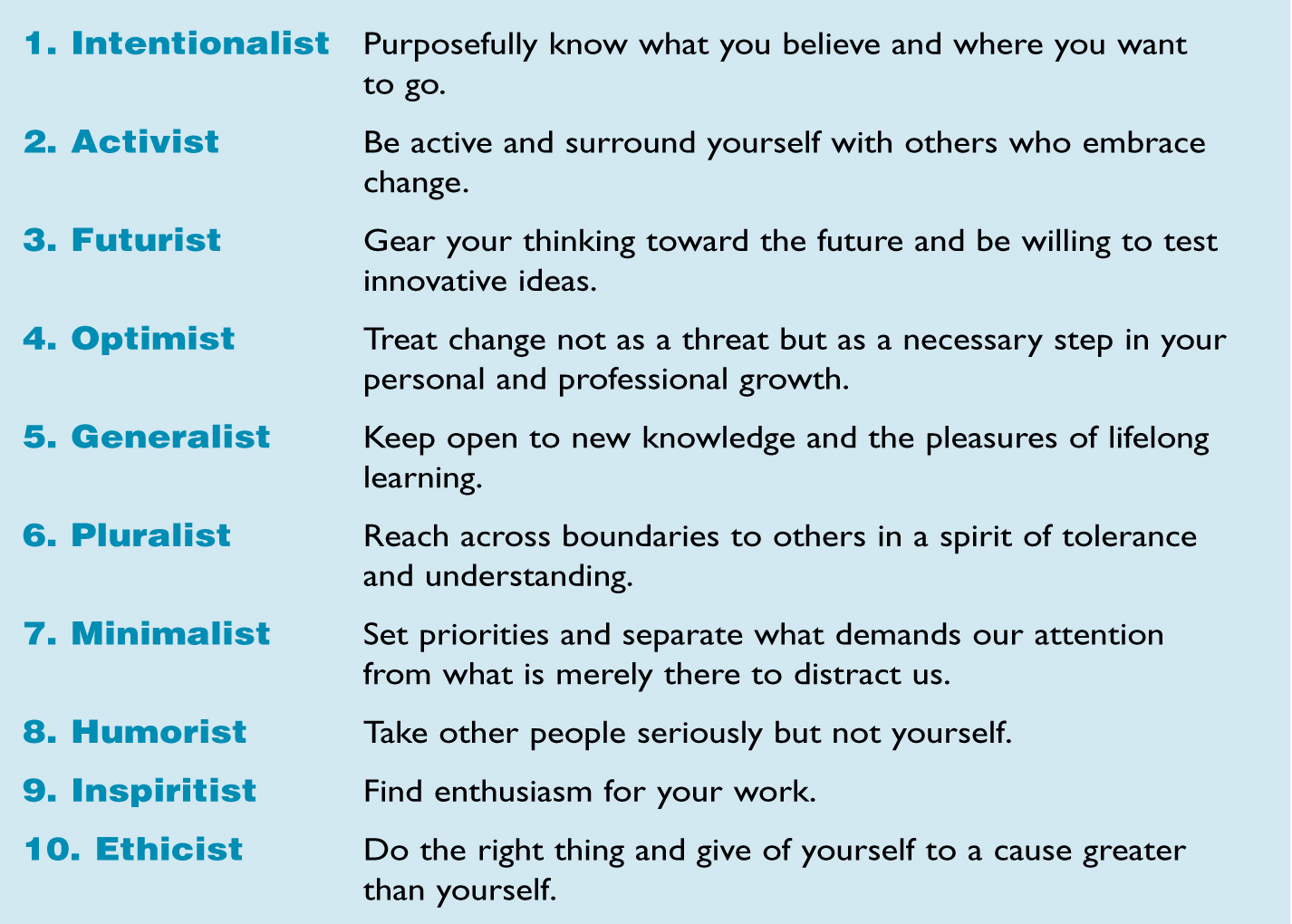I learned very early how important it is to be psychologically young, and as I approach my 75th year, I’m pleased to say that my psychological age is 36. I realize, of course, that we must accept some of the limitations of age, but we do not have to let our spirits fail; indeed, our spirits can soar just as high during the autumn and winter years. I think of the poet Stanley Kunitz’s brave insistence in old age:, “I am not done with my changes yet.” And I think, also, of the actress Ethel Barrymore, who once said that a good life is like a good play: It should have a satisfying third act. In the third act of my life, I’m intrigued with the idea that the autumn years do not take us further away from our youth; rather, they give us an opportunity to stay younger longer.
At each stage of the journey no matter how old we are, no matter how psychologically young we are we need to take stock of where we come from, where we are, and where we are going. These are the questions that the great writer Carl Sandburg asks through his protagonist in the novel Remembrance Rock. In that novel, the main character goes out every year to his “remembrance rock” and sits a spell to contemplate his life. He asks these questions: Who am I? Where have I come from? Where am I going? These three questions, it seems to me, imply a fourth: What is the meaning of my life? Like Sandburg’s hero, we have a responsibility to be cognizant of our journeys to take stock of things as we go, to sit a spell, to reflect. So today, painting in broad strokes, I’d like to talk about the journey of leadership, which really can be a journey into meaning and fulfillment. After all, leaders, according to Warren Bennis, are those who use who they are in creating solutions for tomorrow.

So who are we? It’s a good question, isn’t it? It’s a question that the novelist Mary Hood puts into perfect perspective in writing about the difference between Northerners and Southerners. She says, “Suppose a man is walking across a field. To the question ‘Who is that?’ a Southerner would reply by saying something like ‘Wasn’t his granddaddy the one whose dog and him got struck by lightning on the steel bridge? Mama’s third cousin dead before my time found his railroad watch in that eight-pound catfish’s stomach the next summer just above the dam. Big as Eunice’s arm. The way he married for that new blue Cadillac automobile, reckon that’s how come he’s walking like he has on Sunday shoes, if that’s who it is, and for sure it is.’A Northerner would reply to the same question (only if directly asked, though, never volunteering),‘That’s Joe Smith.’To which the Southerner might think (but be too polite to say aloud),‘They didn’t ask his name, they asked who he is!’” (Mary Hood, “On Being a Southern Writer,” River of Song Project www.pbs.org/riverofsong/pressroom/ pr-month.html).
By following our calling our passion we begin to discover more fully who we are.
Let’s talk for a moment about who we are. Whether you’re a banker, a lawyer, or a corporate leader, all of us want to have some kind of meaning in our lives. All of us want to make a difference. It’s not just making a living that matters, it’s making a life. Recently, I gave a talk to the top leaders of a great corporate entity. I asked them, “How many of you consider your work a calling?” Not one hand went up. At my own university, I asked our faculty the same question. Every hand went up. I submit to you that no matter what our business, we should consider it a calling, or else we ought to get out of it. By following our calling our passion we begin to discover more fully who we are.
What is it that makes work a calling? When I first became a dean at the University of Florida in 1972, I was the only woman dean in the entire state that was not affiliated with nursing or student affairs. I was a child psychologist and had no idea what a leader did, so I read all the books I could on the subject Power!, Looking Out for Number One, The Art of Deception, Dress for Success, Eat for Success, and The Art of Intimidation. All of them had the same thesis:, “I win, you lose.” Finally, I came across In Search of Excellence: Lessons from America’s Best Run Companies by Tom Peters and Robert Waterman, which had a different message:, “It’s not what you know, what you wear, or what you eat that makes a difference. It’s what you believe about people.” Then just recently I read Built to Last: Successful Habits of Visionary Companies by Jim Collins and Jerry Porras, and I found a similar message. Rather than focus on quick fixes or the flavor of the week, these last two books ask us to explore our meaning more deeply and discover the vision of our lives and careers. The best leaders again, according to Warren Bennis are those who enroll others in their vision.
The Decathlon Leader
A colleague and I have been working for a long time on the question, What constitutes leadership? I used to think of a leader as a solo performer, the hero at the helm, always of the command and control variety. Now I think that a leader must be like a decathlon athlete. Because they compete in 10 track and field events, decathlon athletes are good at many things, but they may not be the best at any one thing. Yet when they put it all together, they emerge as remarkable athletes.
Decathlon leaders are the same. We have so many responsibilities as leaders so many different roles to play and we cannot possibly be the best at everything we do. But we can learn to be good at many things and to surround ourselves with people who are enrolled in a shared vision of success.

On a trip I took to the Sequoia National Forest in California, the guide told me that sequoia trees are the largest in the world, the tallest being 300 feet high. Their roots are shallow, lying just under the earth. The secret to their growth is that each tree’s roots reach across to the roots of another sequoia, entangling them so that they can both stand tall. The guide said, “It’s impossible to see a solitary sequoia in the forest.” Isn’t this similar to the idea that we can only stand tall in the company of others who are working toward the same goal who share the same vision?
One of my faculty members recently brought me a story that illustrates the same point: If you take a cell of the heart of an animal and put it in a Petri dish, and then you take a cell from the heart of another animal and put it in the same Petri dish, the cells, each of which at first is beating to the rhythm of the original hearts, begin to beat together. Again, we work best when we work to create a new rhythm together when our hearts, you might say, begin to beat as one.
The decathlon leader believes in sequoias reaching across roots, in cells coming together and he or she invites others to share in work that goes forward joyfully.
QUALITIES OF A DECATHLON LEADER

Ten Characteristics
My colleague and I came up with 10 characteristics of a decathlon leader that is, 10 different ways in which we should address who we are, how we work together, and what our calling is, and then offer that truth in our organizations (see “Qualities of a Decathlon Leader”).
- Be an Intentionalist.This means purposefully knowing what you believe and where you want to go. An interesting metaphor for this characteristic is the starfish. When starfish feed on oysters, they expend very little energy compared to someone using a knife with a great flourish to shuck open the oyster’s shell. Gradually, gently, and continuously, the starfish uses each of its five radially disposed arms in turn to keep steady pressure on the one oyster muscle. While one arm works, the others rest. Inevitably and irresistibly, the oyster shell opens, and the starfish has its meal.
The starfish illustration offers one analogy for how the decathlon leader can address each and every part of an organization’s structure and culture. The five arms of the starfish might be considered metaphors for what I call the five P’s of an organization: people, places, policies, programs, and processes. Working intentionally with great purpose the decathlon leader can bring these five aspects of the institution into alignment, allowing for maximum return for minimal efforts. Everything about the institution should be intentionally inviting, and all efforts should be go toward reaching the same goal. Such intentional alignment eliminates wasted I’d like to define this idea of being an “intentionalist” a bit more fully by offering four ways of issuing invitations to others some negative and some positive. I think you’ll see that we all have it within our power to help change the culture of our institutions simply by being intentionally inviting in all that we do.
- Being Intentionally DisInviting. How many of us have been intentionally disinvited from being a part of something? From being involved in our companies? African-Americans, women, Latinos, nonconformists, and disabled people have long been left out. And how can a company possibly succeed in the long run if it doesn’t show respect for its own employees? While we can never be sure that we are truly motivating others, we can intentionally invite them to see themselves as able, valuable, and responsible.
- Being Unintentionally Disinviting. Often people don’t mean to be disinviting, but even the way we say “good morning” can make somebody feel either welcome or offended. Similarly, the places where we work the environment surrounding us can have a profound impact on our attitudes. Kennesaw State University has grown from 3,700 to 18,000 students since I’ve been president. When I first arrived, I found a cloistered little college with no flowers on the campus. It looked like an institution. I wanted to have flowers, but when I approached our plants manager about putting some in, he said, “We don’t have the staff or the money. We mow right to the walls, and it’s clean and pretty.” I asked him for a few potted plants, just to welcome some important officials on their upcoming visit, and he agreed. After geraniums were planted at the student union, I would regularly brag about them to everybody. What do you think happened? Our campus today is a riot of beauty. Do you know the number one reason why people apply to a certain college? The way it looks. To be unintentionally disinviting creates an unnecessary obstacle.
- Being Unintentionally Inviting How many of you have people in your organization who are the salt of the earth? They do good things but don’t know how or why. For example, at our university, every year we give $1,000 dollars to the best teacher. I then ask that person to give a major talk to our campus on what makes them a great teacher. Every year I’ve gotten the same response: The teacher says, “I don’t want to do that. It just comes to me. I just get in there and teach.” I say, “I just gave you $1,000 dollars. I want you to talk about what makes you a good teacher.” They have to labor over the answer. Imagine getting that response if you asked the question to the pilot flying the plane you’re on. We have to be able to articulate, to validate, and to replicate that which we do.
- Being Intentionally Inviting. To be intentionally inviting to others is to encourage them to see themselves as able, valuable, and responsible, and to find ways to invite them to get involved. One thing I recommend is to go back to your organizations and identify some of the unintentionally disinviting things that are happening there. Thankfully, we have laws that keep us from intentionally disinviting people. But if there are some unintentional ways in which the people, places, programs, policies, and processes of our organizations send a negative signal, let’s find those things and change them.

We have to be able to articulate, to validate, and to replicate that which we do.
- Be an Activist. I’ve found that there are four ways that people respond to change. As an illustration, imagine these responses to news of a party. The first response is “There is no party.” These people brighten the room when they leave it. They get that tone in their voice that says, “It won’t work. We tried that 32 years ago, it didn’t work then, and it won’t work now.” The second response is “There is a party, and I didn’t get an invitation.” Even if you declare that you sent the e-mail announcement to everyone, they didn’t get it, they’re not appreciated, and they’re not going. The third response is “There’s a party, and I’m invited, but I’m not going.” These people think they’re not good enough, with it enough, or smart enough. They’re the ones that say, “I’ve been to the party with all my hopes and buried them one by one.” The fourth response is “There’s a party, I’m invited, and I’m going.” They may not be with it enough, smart enough, or strong enough, but they might be and they are willing to try. Let’s invite people to come to the party who welcome change. Let’s be active and also surround ourselves with activists.
- Be a Futurist. The great hockey player Wayne Gretsky, in a wonderful, almost Zen-like statement of his playing philosophy, said, “You skate to where the puck will be, not where it is.” To be a futurist means skating to where the puck will be. It involves anticipation, monitoring all the boundaries so that you have an informed idea of what will be coming next, and it requires a certain amount of risk-taking. Go and find out what the best practices are and put them into your own model of the successful institution. Better yet, experiment with creative practices of your own; be willing to put innovative ideas to the test. Don’t wait to play catch-up later in the game, but get ahead now by gearing your thinking toward the future.
- Be an Optimist. Pessimists curse the wind. Optimists believe the wind will change. Winston Churchill said, “To accept change, you must change often.” The author Gail Godwin once described people as being either congealed or fluid. Congealed people reach final form in their youth; they get stuck in a role and repeat themselves. Fluid people are those who are constantly making new trysts with life.Optimists are also more willing to change, even when they have concerns about outcomes. The decathlon leader treats change not as a threat but as a necessary step in personal and professional growth. In The Nature of Leadership, Stephen Covey encourages leaders to approach change in precisely this way:, “For the effective leader, change is a friend, a companion, a powerful tool, the basis of growth.” Only the optimistic leader embraces change as a companion.
- Be a Generalist. To be a generalist means knowing something interesting about many things. Oscar Wilde said that when you’re invited to a dinner party, you have a moral obligation to be interesting. I know people who go through life unimpressed. As a consequence, they’re boring. A generalist is a lifelong learner, always alert to fresh ideas and new subjects. He or she knows that lessons can be gleaned from the most unlikely sources, and finding them requires that we remain curious and inquisitive. We might lament with the poet the life so short, the art so long to learn but by keeping ourselves open to new knowledge, we will spend less time lamenting how little we know and more time discovering the true pleasures of lifelong learning.
- Be a Pluralist. Decathlon leaders understand that honoring diversity is crucial to the work of being intentionally inviting, just as it is a key component of lifelong learning. Nearly 20 years ago, Dr. Ernest Boyer, former U. S. Commissioner of Education, wrote of the importance for students to “be informed about people and cultures other than their own.” He pointed out that “if students do not see beyond themselves and better understand their place in our complex world, their capacity to live responsibly will be dangerously diminished.” We can substitute leaders (or, indeed, human beings) for students in Boyer’s formulation and discover the importance of becoming a pluralist.To live responsibly, Boyer implies, is to look outside oneself. It means looking beyond everything that is immediate and familiar and comfortable. It means challenging yourself, perhaps the most important requirement of lifelong learning. Today, this imperative to look outside ourselves is more pressing than ever. For all of us, exposure to other cultures is essential if we are to prepare adequately for the future. The pluralist must learn to reach across boundaries to others in a spirit of tolerance and understanding.
- Be a Minimalist. The minimalist is an expert at setting priorities and separating what demands our attention from what is merely there to distract us. Years ago, I read that, over a lifetime, the average American will spend seven years in the bathroom, six years eating, five years waiting in line, four years cleaning house, three years in meetings, one year searching for lost keys, eight months opening junk mail, and six months sitting at red lights. How much time will we waste on our computers or making calls on our cell phones? What can we minimize so that we can concentrate on what is truly important? Four and a half years ago, I gave up watching the 11 o’clock evening news. I had just heard our commencement speaker say that if you spend 15 minutes a day studying something you know nothing about, in one year you will become something of an expert on that subject. Besides, I knew that I would see and read the news the next morning anyway. Guess what I substituted for the first 15 minutes? Reading poetry. I am now something of an expert on poetry, and more importantly, it has enriched my life immeasurably. In the second 15 minutes, I practice putting on a golf machine. I now play golf in the low 80s if it gets any hotter than that, I just don’t play.
- Be a Humorist. Don’t take yourself too seriously, but do take other people very seriously, indeed. There’s nothing more potentially damaging to professional relationships than the attitude of those who take themselves too seriously, and especially those who are constantly stroking their own egos. The world is much, much bigger than any one individual. As you can imagine, the academic world has more than its share of overfed egos, people who have fooled themselves into believing their opinions are the only ones that matter. How can such a person cordially invite our students to enter into lives of meaning, fulfillment, and purpose? Such professors are not modeling the essential humility that distinguishes the authentic scholar, who can say with Chaucer’s Clerk:, “Gladly would he learn and gladly teach.”We must be humble in our work, and we must be humble in our interactions with others. As soon as we show that we are willing to laugh at ourselves, we become more trustworthy, especially if we consistently show respect toward our colleagues and associates. Who could resist an invitation offered with humor and humility? It’s a winning combination for the decathlon leader.
- Be an Inspiritist. Find enthusiasm for your work. Psychologist Abraham Maslow once described true creativity as work that goes someplace joyfully. In 1996 I was on the board of the Paralympics sports for athletes with disabilities when the games were held in Atlanta, Georgia. At the opening session, a young man with no use of his legs climbed hand over hand 96 feet up the Paralympics tower while clutching the torch. When he reached the top, he lit the torch and held it high with one hand. It was a remarkable triumph of the human spirit. Sometimes we forget how hard people must fight to succeed against the odds, and sometimes we surrender too easily to even the smallest obstacles in our way. We must be of good spirit. We must not be dismayed. How else will we raise the torch in triumph?
- Be an Ethicist. This last characteristic of the decathlon leader really is the foundation for all the others. It has to do with character. It’s about doing the right thing, giving of yourself to a cause greater than yourself, giving something back. In 1982 Time magazine’s “Man of the Year” was a machine: the computer. Surely, there must have been someone a human being, I mean more deserving of the title. My choice that year would have been the man in the water in the Air Florida 90 crash. On January 13, 1982, an Air Florida plane hit the 14th Street Bridge over the Potomac River in Washington, D. C. (ice had formed on the wings) and began to sink as it landed in the water. Cameras documented the few survivors clinging to the aircraft’s tail as a hovering helicopter dropped life vests and a lifeline into the water. Time and again, one man reached for the lifeline, pulled it to himself, and then passed it along to someone else. Finally, when everyone else had been rescued, the helicopter returned for the man, but, too chilled by the cold, too diminished by his efforts to save the others, he slid beneath the waters and drowned before our very eyes on television.He was an ordinary burly, balding, mustached man. When I think of him, I think of Joseph Campbell’s idea of the “hero with a thousand faces.” And that is what heroes are: Ordinary people doing extraordinary things. Later, I learned he worked at the Federal Reserve Bank in Georgia and went to Peachtree Presbyterian, where my husband and I worship. You see how close it gets?Four years ago, as I gave the commencement address at the Citadel, the Military College of South Carolina, something possessed me to put away my formal talk and share the episode of the last man in the water. I noticed that everyone was being very, very attentive, and when I sat down, the Citadel’s general walked to the microphone and said, “Oh, Dr. Siegel, closer than that. He was a graduate of the Citadel.” This summer, as I gave the baccalaureate address at Woodward Academy in Atlanta, again I put aside my formal remarks and closed with this story. And again, I noticed everyone being very attentive. At the end of my talk, the headmaster said, “Oh, Dr. Siegel, closer than that. He was the father of one of our graduates.

As soon as we show that we are willing to laugh at ourselves, we become more trustworthy, especially if we consistently show respect toward our colleagues and associates.
We make our living by what we get, but we make our lives by what we give.
The “hero with a thousand faces” is right next to us, you see. It should make us pause and reflect. Certainly, few of us will have to make that kind of sacrifice, but still we might ask ourselves if we have the ethical character of that “Man of the Year.” And what of the thousand smaller sacrifices we are called upon to make? Will we do the right thing? These are the questions of the leader as ethicist.
We make our living by what we get, but we make our lives by what we give. As I travel around the country speaking at colleges, I remind people that we must be about service learning. We must take what we know and make a difference in our society. We’ve got to do it in our companies, too. What a difference we could make as leaders if we gave something back to our culture!

Standing Tall
My message has been a simple one: It’s what you already know that’s important. I’ve invited you to see yourselves as able, valuable, and responsible, and to see your role as one of sending invitations to others to let them know that they, too, are able, valuable, and responsible. Let us be like the sequoias and stand tall in each other’s company. Let us become decathlon leaders intentionalists, activists, futurists, optimists, generalists, pluralists, minimalists, humorists, inspiritists, and ethicists. I’d like to close with a story entitled “Whose Job Is It?” It’s a story about four people named Everybody, Somebody, Anybody, and Nobody. There was an important job to be done, and Everybody was sure that Somebody would do it. Anybody could have done it, but Nobody did it. Somebody got angry because it was Everybody’s job, but Everybody thought Anybody could do it. Still, Nobody realized that Everybody wouldn’t do it. It ended up that Everybody blamed Somebody when Nobody did what Anybody could have done.
Whose job is it? Comedian Sam Levinson said it best., “If you’re looking for a helping hand, you’ll find one at the end of your arm.” It’s everybody’s job, isn’t it? We are all responsible for doing the best job that we can in all of our endeavors. There are no givens in the odyssey of leadership in the quest for meaningful work, lifelong learning, self-fulfillment, and service to others and community. But the quest itself, if undertaken seriously and with care, should produce a life of meaning and fulfillment.
Betty Siegel has been president of Kennesaw State University since 1981. She was the first woman to head an institution in the 34-unit University System of Georgia.
